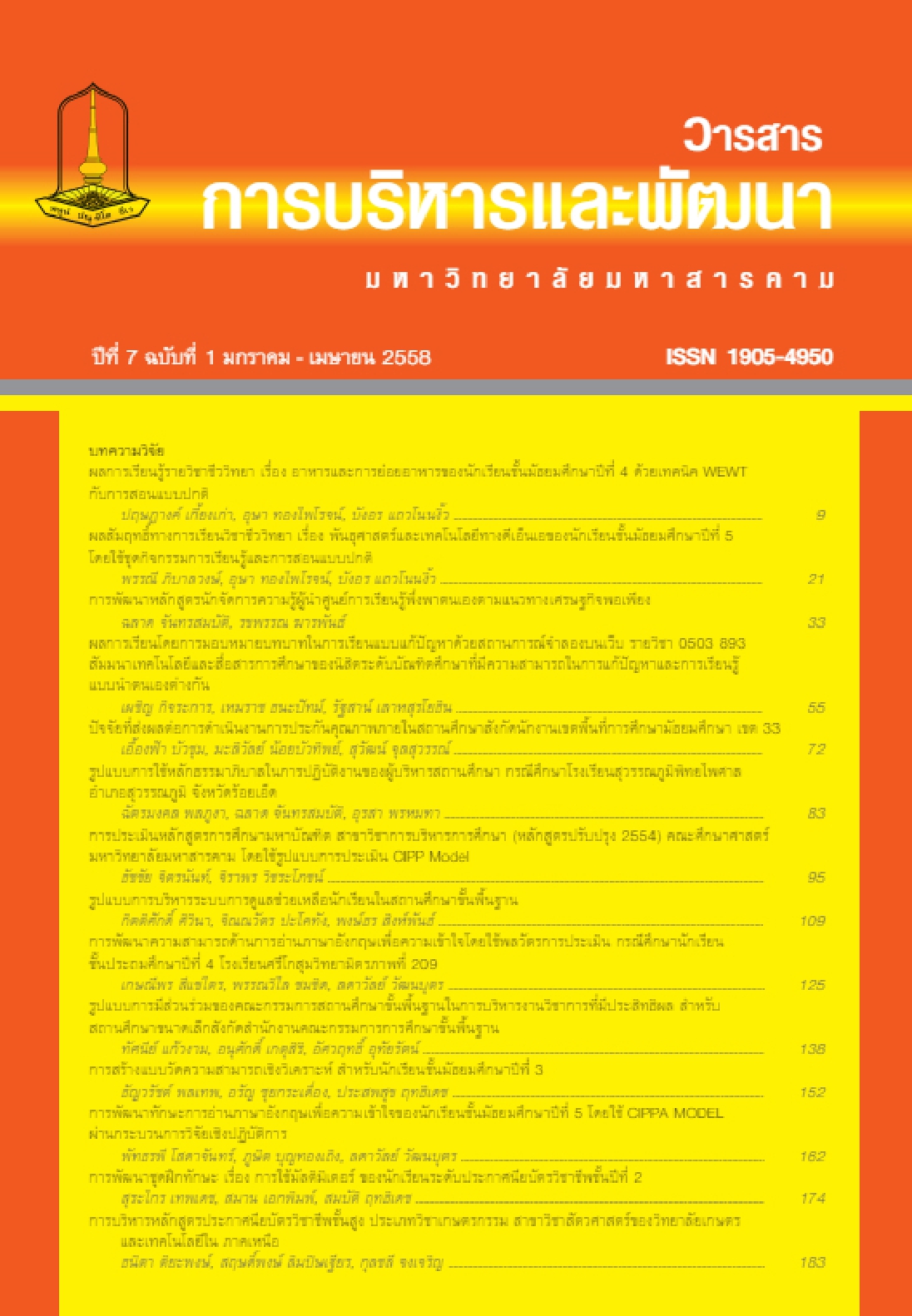การพัฒนาความสามารถด้านการอ่านภาษาอังกฤษเพื่อความเข้าใจโดยใช้พลวัตรการประเมิน กรณีศึกษานักเรียนชั้นประถมศึกษาปีที่ 4 โรงเรียน ศรีโกสุมวิทยามิตรภาพที่ 209
Main Article Content
บทคัดย่อ
การวิจัยครั้งนี้มีวัตถุประสงค์เพื่อ 1) พัฒนาความสามารถด้านการอ่านภาษาอังกฤษเพื่อความเข้าใจโดยใช้พลวัตรการประเมินของนักเรียนชั้นประถมศึกษาปีที่ 4 2) ศึกษาความสามารถในการอ่านภาษาอังกฤษเพื่อความเข้าใจ ก่อนเรียนระหว่างเรียนและหลังเรียนและ 3) ศึกษาความพึงพอใจของนักเรียนชั้นประถมศึกษาปีที่ 4 ต่อการเรียนภาษาอังกฤษเพื่อความเข้าใจ กลุ่มตัวอย่างได้แก่ นักเรียนชั้นประถมศึกษาปีที่ 4/2 โรงเรียนศรีโกสุมวิทยามิตรภาพที่ 209 อำเภอโกสุมพิสัย จังหวัดมหาสารคาม สำนักงานเขตพื้นที่การศึกษาประถมศึกษามหาสารคาม เขต 3 ภาคเรียนที่ 2 ปีการศึกษา 2555 จำนวน 38 คนได้มาโดยการเลือกแบบเจาะจง (Purposive Sampling) เครื่องมือที่ใช้ ได้แก่ แผนการจัดการเรียนรู้จำนวน 12 แผน แบบทดสอบชนิด 4 ตัวเลือก แบบทดสอบความสามารถด้านการอ่านภาษาอังกฤษเพื่อความเข้าใจชนิด 4 ตัวเลือก จำนวน 30 ข้อ และแบบสอบถามความพึงพอใจแบบมาตราส่วนประมาณค่า 5 ระดับ จำนวน 10 ข้อ สถิติที่ใช้ในการวิเคราะห์ข้อมูลได้แก่ ร้อยละ ค่าเฉลี่ย ส่วนเบี่ยงเบนมาตรฐาน และค่า t (t-test)
ผลการวิจัยพบว่า
1. นักเรียนชั้นประถมศึกษาปีที่ 4 มีคะแนนการทดสอบหลังเรียนสูงกว่าก่อนเรียนอย่ามีนัยสำคัญทางสถิติที่ระดับ .01 ซึ่งมีคะแนนเฉลี่ยของความสามารถในการอ่านก่อนเรียน ความสามารถในการอ่านภาษาอังกฤษเพื่อความเข้าใจโดยใช้พลวัตรการประเมินสำหรับนักเรียนชั้นประถมศึกษาปีที่ 4 มีคะแนนที่ส่งผลต่อการพัฒนาความสามารถในการอ่านหลังเรียนสูงกว่าก่อนเรียนอย่างมีนัยสำคัญทางสถิติที่ระดับ .01 ซึ่งมีคะแนนเฉลี่ยของความสามารถในการอ่านก่อนเรียนและหลังเรียนเท่ากับ8.34 จากคะแนนเต็ม 10 คะแนนและ 24.24 จากคะแนนเต็ม 30 คะแนนตามลำดับ 2. นักเรียนชั้นประถมศึกษาปีที่ 4 มีพัฒนาการความสามารถด้านการอ่านภาษาอังกฤษเพื่อความเข้าใจโดยใช้พลวัตรการประเมินก่อนเรียนระหว่างเรียนและหลังเรียนคิดเป็นร้อยละ 57.1, 81.05และ 98.02ตามลำดับ3. นักเรียนชั้นประถมศึกษาปีที่ 4 มีความพึงพอใจต่อการเรียนภาษาอังกฤษโดยใช้พลวัตรการประเมินโดยรวมอยู่ในระดับมากที่สุด ( x̅=4.51)
Downloads
Article Details
เอกสารอ้างอิง
Achara Wongsothorn. (1995). Language Test Construction Guideline. Bangkok: Chulalongkorn University Printing House.
Achara Wongsothorn. (2001). Testing and Evaluation of English Learning. 2nd ed. Bangkok: Chulalongkorn University Printing House.
Amonrat Kasemsuk, Thongsuk Wansan, and Somboon Satalalai. (2009). A Study of the English Learning Outcome of Matayom Suksa 3 Student by using KWL-Plus and a Conventional Method in Surin educational service area office 2. Graduate School Journal, Surindra Rajabhat University 3 (1): 1-7.
Anton, Marta. (2009). “Dynamic Assessment of Advanced Second Language Learners,” Foreign Language Annals. 42(3): 576-598 ; Fall
Kitjanat Tangjitnusorn. (2009). Study of Undergraduate Students’ English Reading Ability and Identity via Problem Solving Process on Hi5. Master of Education in Teaching English. Chiang Mai: Chiang Mai University.
Kozulin, A. and Grab, E. (2002). “Dynamic Assessment of EFL Text Comprehension of at-Risk Students,” School Psychology International. 23(1): 112-127
Maha Sarakham Primary Educational Service Area Office 3. (2011). Report of the Basic Education Assessment for Prathom Suksa 4 Students, Academic year 2011. Retrieved October 13, 2011, from www.mkarea3.go.th
Mardani, Mehdi and Manssour Tavakoli. (2011). “Beyond Reading Comprehension: The Effect of Adding a Dynamic Assessment Component on EFL Reading Comprehension,” Journal of Language Teaching and Research. 2(3): 688-696 ; May,
Maslow, Abraham. (1970). Motivation and Personality. 2nd ed. New York: Harper and Row Inc,
Moore Brown, Barbara, et al. (2006). Using dynamic assessment to evaluate Children with suspected learning disability. retrieved August 14, 2011, from http://www.highbeam.com
Nipaporn Promchuay, Panida Tipwichai, and Maneepat Bunchoo. (2009). The Effects of Using Dynamic Assessment on the Students’ Reading Ability. Independent Study in English. Pitsanulok: Naresuan University.
Pachongkarn Phuvipadawat. (1999). Development of Innovation in English Language Teaching for Dissemination. Chiang Mai: Department of Secondary Education, Faculty of Education. Chiang Mai University.
Phatcharaporn Boonthama. (2009). Use of the IDEAL Problem-Solving Strategy for Promoting English Reading Comprehension and Problem-Solving Ability of Mathayom Suksa 5 Students. Master of Education in Teaching English.Chiang Mai: Chiang Mai University.
Secondary Educational Service Area Office 26. (2010). National Test Results 2010. Kosumpisai: Maha Sarakham.
Surawat Thongbu. (2007). Educational Research. Maha Sarakham: Faculty of Education, Rajabhat Maha sarakham University.
Stanfa, Kathleen M. (2010). “Differentiating Among Students: The Value Added of a Dynamic Assessment of Morphological Problem Solving”. Dissertation Abstracts International. Pittsburgh: University of Pittsburgh,
Yildirim . (2008). “Vygotsky’s Sociocultural Theory and Dynamic Assessment in Language Learning,” Anadolu University Journal of Social Sciences. 8(1): 301-308.


